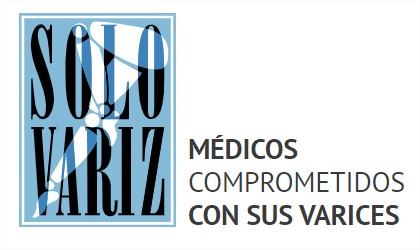Types and
diagnosis of
varicose veins
Types of varicose veins
Depending on the degree of severity in patients, we can classify varicose veins in four major types:
Varicose veins Degree 1. Known as telangiectasias TB or spider veins they represent basically an aesthetic problem. They may cause symptoms in patients such as heavy or tired legs. This type of veins produce an unappealing aspect that can be easily removed with the SOLOVARIZ treatment.
Varicose veins Degree 2. They are called Reticular varicose veins. Thay cause uncomfortable pains and legs may feel heavy, but mostly, they generate unaesthetic capillaries. These veins are much more visible due to their size and dilation. They can and must be treated in order to prevent further and more complicated health problems.
Varicose veins Degree 3. They are collateral; appear as very swollen and unaesthetic causing relevant pain, itching and eczema visible on the patient. They bring along important consecuences and treatment is necessary to avoid them.
Varicose veins Degree 4. Known as saphenous varicose veins. There are two internal or long and two external or short that bring along pain, cramps, harm to the tissue, varicorragia and even varicose ulcer.
Whatever the type of varicose vein, the SOLOVARIZ method achieves the complete elimination of varicose veins.
Vascular spiders
Spider veins or capillaries, they are small veins that have dilated.
These already dilated capillaries warn us of a previous pathology whose importance will depend on the varicose veins that provoke them, that is why before dilated capillaries, we must diagnose the reason for their training in order to apply an appropriate pre-treatment. In this way, the first question to clear is to know if it is saphenous, collateral or reticular varicose veins.
Once this first question has been analyzed, assessed and diagnosed, these pathologies can be resolved in an effective and definitive way, which are always accompanied by greater discomfort than those that are merely unattractive. Actually, dilated capillaries (spider veins) tell us that there is something more altered in the return venous circulation. Therefore, it is necessary to analyze, assess and diagnose the origin of this alteration properly to treat it adequately and subsequently be able to eliminate those capillaries or spider veins.
Diagnosis of varicose veins
When a varicose vein study is made to make a diagnosis, the main device used is Eco-Doppler. It is also called Duplex, since in reality it is the sum of two diagnostic systems in a single device: the Echograph and the Doppler.
Ultrasound
Make a study of the shape, the anatomy of varicose veins. It allows us to see the venous vessels, their route and location. The situation of the veins is never the same or even in the different legs of the same person. Thanks to this device and the study that allows us, we can analyze the dilation of the veins as the first test of the formation of varicose veins since the veins are small in diameter compared to varicose veins, which can increase the size of varicose veins. in 30 times.
If this study already induces us to think that we are facing a diseased vein (a varicose vein), we can not assure that we have a varicose vein (although its diameter is very large), until we confirm the study with the system Doppler.
Doppler
This study allows us to visualize the direction of the blood in the veins:
- Ascending, it is a healthy vein that brings the blood back to the heart.
- Descending, it is a varicose or varicose vein, which leads to the blood in descending direction towards the ankle.
How does the Doppler work?
This device converts the upward direction of the blood into a color flow, for example blue, and converts the downward flow into another color, for example red, informing us about whether a varicose vein is carrying blood towards the patient's feet. find yourself standing. With the study and analysis of the information on the shape, location of the veins and the ascending or descending direction in which the blood flows, an exact diagnosis is completed in 99% of the varicose disease.
When performing varicose vein removal treatment based on the indications of both systems, we can offer a complete and effective solution.
In this way, the Eco-Doppler study is the basic study to be able to perform a varicose vein treatment with guarantees and to be able to evaluate its evolution.

